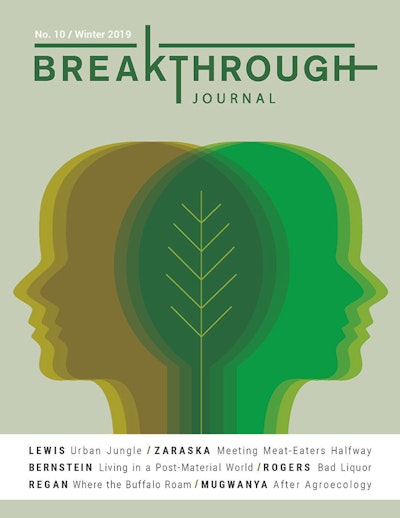Why are wine writers so unwoke about science and the environment?
A response to Ted Nordhaus's “On the Nature of Wine”
-
-
Share
-
Share via Twitter -
Share via Facebook -
Share via Email
-
Ted Nordhaus’s essay “On the Nature of Wine” rightly noted that natural wines are as much a product “of modern science, innovation, and commerce” as conventional ones, and it brought to mind related questions. Why are wine writers so unwoke about science and the environment?
My framing refers to Jon Bonné’s timely essay, “Why Is the Wine World So Un-Woke?” which discusses industry blind spots. But Bonné missed some wine taboos: vineyard pesticide use and resistance to hybrid grapes. I think we should examine those topics in the Anthony Bourdain spirit Bonné mentions: with a “willingness to poke at the dark underlining of putatively shiny things—including the food world he loved…. [Bourdain] felt that an essential part of loving a thing was to tear down the false romanticism surrounding it.”
Bonné mentions gender gaps, sexism, class snobbery, and labor issues in his essay, but the word “pesticide” doesn’t appear. That’s typical — it’s a no-show in Bianca Bosker’s bestselling Cork Dork, in Adam Rogers’s Proof: The Science of Booze, and in Bonné’s The New Wine Rules — all fine books. I’m guilty, too: the first edition of my Tasting the Past omitted this fact: in California alone more than 260 million pounds of pesticides were applied to vineyards between 2007 and 2016, according to state records. “The long term trend over the last two decades is an increasing area treated for all pesticide types except for sulfur which has tended to fluctuate,” officials note.
Andy Walker, the Louise Rossi Endowed Chair in Viticulture at the University of California, Davis, says the general practice is to spray before diseases or pests even appear, as a safeguard. “It’s like saying, ‘I’m not going to allow any leafhoppers, so I’m going to kill every one in the whole area before they can possibly get my vineyard.’”
I know that industrial fertilizers and pesticides have greatly increased crop yields around the world, and that grapes are particularly susceptible. But that was the science of the past. Now grapes have a better option, and I don’t just mean biodynamics or organic farming. Walker and other scientists have discovered that many wild grapes contain natural resistance in their DNA to diseases, pests, and even drought. It shouldn’t be a shock to wine lovers, given the well-known story of how American grape rootstock resists phylloxera.
Adding just a few percent of Vitis arizonica DNA (or other wild grape) to classic varieties through cross-breeding could reduce pesticide and herbicide applications, yet the harvest would still be bountiful, and the tastes wouldn’t change.
That sounds like a fantasy. Everybody wins. The environment and fieldworkers aren’t harmed, the vineyard saves significant amounts of money, consumers get a genuinely feel-good message. There’s more: cross-breeding could help classic French grape varieties cope with rising temperatures from climate change.
Who would oppose such progress?
The tragic answer is that much of the wine world seems resistant or indifferent. Why? One answer is that we all gravitate toward exploring the wonderful range of flavors and aromas that wine offers. But another is that industry traditions about supposedly “noble” grapes contain unhealthy doses of Victorian prudishness and outright viticultural apartheid. Or as Bonné notes, the industry “has a nearly pathological aversion to its less-than-perfect side.”
The notion of letting Pinot or Chardonnay breed with a wild grape isn’t just sacrilege — it’s prohibited by law in France and elsewhere, or considered a marketing risk. But consider what that really implies.
“If applied to any other category you’d say this is just plain old racism. A little bit of wild ancestry? Ah, you’re still a hybrid. You’re inferior to the noble European grapes,” says Sean Myles, an expert on grape genetics at Dalhousie University in Nova Scotia.
Let me be clear: the wild/classic hybrid grapes I’m talking about can (and have) been made via old-fashioned plant breeding: one vine pollinating another. The scientists just use the precise DNA information to home in on the best wild candidates. Deirdre Heekin’s acclaimed Vermont wines come from hybrids created at the University of Minnesota, and consider her take: “(A) conventional winegrower recently commented to me that he was envious of our cold-hardy varietals because of their built-in resistance. We have better chances of success growing organically,” Heekin wrote in her book An Unlikely Vineyard.
Let’s take this a step further. Say a scientist actually used genetic modification — the new DNA-editing tool known as CRISPR — to put disease-resistant DNA from a wild grape in a supposedly “noble” variety such as Pinot. What, exactly, is wrong with that?
Pinot didn’t emerge from a bolt of vineyard lightning thrown by Dionysus. All our classic wine grapes have evolved from wild grapes, sometimes from accidental crossings and sometimes with human help.
So Heekin sees a place for hybrid vines in her organic/biodynamic vision, but she’s hardly alone. Consider this plea from the legendary Piemonte producer Angelo Gaja, known for his classic Barolo and Brunello wines. “If researchers are not allowed to apply new genetic techniques in their work, our vineyards will have no future,” Gaja wrote in 2015. “It's time to break the taboo around genetically modified vines: they will be Italian wine’s salvation…. The world of wine must avert the greatest danger: that of doing nothing!”
But unfortunately that is where most wine writers are at: doing practically nothing to confront pesticide issues head on. Oh, we write about flavors, aromas, tradition, and even science from every angle possible, but rarely use the dreaded P-word. Even this recent CRISPR article in SevenFiftyDaily is more about explaining the technology, though it has these telling comments from legendary UC Davis wine scientist Carole Meredith: “Precise and controlled gene editing is no cause for alarm. [But] I think there will be considerable resistance among consumers and the wine trade. People fear that which they do not understand, and very few nonscientists have any understanding of genetic modification.”
If you don’t think the industry has a problem, consider this: when San Francisco Chronicle wine writer Esther Mobley wrote about Andy Walker’s work in 2016, the original headline was, “Can ‘Frankengrapes’ Save California Wine?” The Chronicle changed the headline, but the damage was done.
I think the hesitation is also because we haven’t really faced who is most at risk from pesticides. It’s not the consumer or the sommelier. It’s the farmworkers who apply pesticides, which can be sprayed on vineyards 10, 15, or even more times yearly. Show me an influential wine writer or magazine that has done a profile on one of the low-paid and often anonymous field workers who spray our beloved grapes. Yet there have already been lawsuits in France over exposures, and a French documentary about risks to children in the Bordeaux region.
I know organic and biodynamic farming has a place. But it is much easier for small producers who sell bottles in the $25 to $45 price range to make the transition, and they are only a tiny portion of the market. Organic farming also tends to produce lower yields per acre. It’s not a solution for everyone, much as we might wish it to be.
Even more than all of that, I struggle to understand what traditionalists or natural wine supporters fear. What could be more natural or traditional than using wild grape DNA? I suspect the wild grape DNA story would make a nice sales pitch to consumers, but somms and retailers can better judge that.
There are other arguments for grape cross-breeding, too. Scientists say the obsessive focus on just a handful of so-called “noble” grapes has created a global monoculture ripe for pandemics, such as those that hit Irish potatoes in the mid-1800s and the Cavendish banana in the 1950s. “It’s really only a matter of time. If we just keep using the same genetic material, we’re doomed,” says Myles.
The problem is that Pinot and other famous grapes have been endlessly reproduced by grafting, not seeds or cross-pollination, so as to preserve precise flavor and aroma profiles. We’ve shut down vineyard love affairs, so the grapes are essentially clones, genetically frozen in time, while diseases, insects, and pests rapidly evolve into new threats.
Cross-breeding could also have climate benefits, since some varieties have natural resistance to heat and drought. Yet a 2018 paper in Nature Climate Change (Wolkovich et al.) found that winemakers are “investing in an increasingly limited portfolio at exactly the time when a large diversity of varieties is most needed.” Even worse, the heat-resistant, late-maturing varieties “are almost entirely excluded” from new plantings. The Nature authors note that many countries plant 70 to 90 percent of vineyard acreage with just 12 European varieties — that’s less than one percent of the available grape diversity. But try telling Burgundy winemakers that Pinot should cross with a bit of Sicily’s Nero d’Avola.
Ironically, the entire notion of a “natural order” of wine is a fiction. “Noble” French grapes are a human invention. More than 95 percent of wild grapes are either male or female, but a tiny group are self-fertilizing hermaphrodites — and Neolithic humans began domesticating those vines because they consistently produce. Virtually every commercial wine grape in the world is descended from that early choice, and we have been cross-breeding grapes for at least 8,000 years.
Now we have a viticultural Catch-22: science has answers to help winemakers cope with disease and climate change, but blind faith in questionable traditions delays progress.
I think we as wine writers share some of the blame. Of course there are occasional stories about hybrid grapes or pesticides — Jancis Robinson seems to cover everything. But here’s the thing: Robinson, Bosker, Mobley, Eric Asimov, Alice Feiring, Bonné, Lisa Perrotti-Brown, Karen MacNeil, and other luminaries are wine influencers in the biggest and best sense of the world, with impact gained through years or decades of hard work. Yet occasionally mentioning a serious issue isn’t the same as taking a stand. The question is whether wine influencers will use their clout to promote cross-breeding as a way to reduce pesticide use.
If writers and somms recognize that dark side of vineyards and call for scientific options to reduce it, I think we all benefit. And if we don’t push for those changes, what does that say about us?


